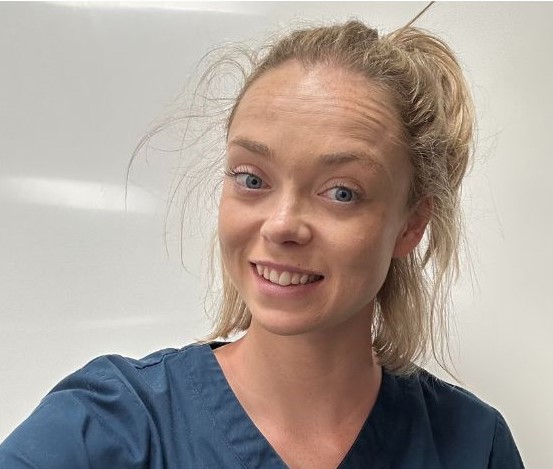With a cool head and the ability to keep calm, vet Harriet Robinson felt she had the right temperament to step into the high-pressure world of ECC medicine. But Harriet, now a key part of the team at Vets Now’s Bristol clinic, tells us why she’s so glad she chose to do Cutting Edge to smooth the transition.
What’s your veterinary background?
I’m that classic case of someone who wanted to be a vet ever since I was a little kid. All my school subjects were geared towards vet school and after applying unsuccessfully first-time round, I then got three offers next time. Bristol Vet School was always my top choice, so I went there and graduated in 2020.
Was ECC something that was always on your radar?
I knew I wanted to do small animal work and I did always have an interest in emergency and critical care. My nature is such that I don’t get really stressed under pressure and I found ECC interesting and was attracted by being able to make a very poorly animal better because of what you did. I was set to spend the elective placement in my final year at university at Vets Now, but it didn’t happen because of Covid.

So, what did you do after graduating?
I moved to the Cheshire area to take a primary care job in a group that had a number of practices and a big 24-hour hospital. I had a taste of doing emergency out-of-hours there before taking another small animal primary care job in Dorset. It was there I decided that really wasn’t for me and I wanted to move into ECC.
And how did you take that step?
I’d been to a CPD event hosted by Vets Now, which I found really interesting. I knew about Cutting Edge from my time at Bristol and it was spoken about very positively there. Having been out for two-and-a-half years by the time I did my interview, I felt I had the experience and knowledge to go straight in with doing it. However, I was offered the option of doing Cutting Edge and I’m so glad I did. It was definitely the right choice and it made me feel so much more confident in my decision-making by the time I stepped into clinic.
So, how did it work?
I started in March of 2023, and it was 10 weeks in total, with a mix of visits to the support office in Dunfermline, time in clinic and some online. There were 13 of us and we had two blocks – two weeks early and then two weeks later – at Dunfermline during which time we learned so much and were so well looked after. We stayed at lovely lodges at Loch Leven, and I made such good friends some of us are going away on holiday together. We also have a group chat which, as well as just keeping in touch, is great for getting a second opinion on cases as someone is also bound to be working at the same time.

Was there anything you found especially useful?
We use a blood gas analyser which you wouldn’t have in a normal day practice. I remembered learning about that in university, but I hadn’t used it in practice. So, when we had sessions with that it was really helpful.
Then there was just the process of triaging cases. In first opinion you will work through your consults in a set order. But in emergency you obviously deal with cases in order of the greatest immediate need. So, we had sessions on switching your focus and quickly prioritising, just as you might do in a A&E in hospital.
How has your time been since you completed Cutting Edge?
I was at Salisbury initially and then moved back to the Bristol area last May, which I obviously know. I’ve loved my first year at Vets Now and surprised myself with how quickly I got used to the nights. I feel I’ve got so much time off to do other things during the day. I’ve started doing a lot of running – which you don’t feel like doing in the evening when you’ve been working all day in general practice – and I’ve signed up to take part in next year’s London Marathon.
Finally, are there cases you’ve come across where you’ve been able to directly put into practice what you learned on the Edge course?
There have been quite a few, but I especially remember a young dog which came in having seizures. They continued after we’d administered medication and when we spoke to the owners, it turned out he’d eaten mouldy food. We had gone through a lot of potential toxin ingestions on Edge and it immediately rang a bell with me that there was one medication, Intralipid, that could really help. It’s not something we’d have access to in primary care and I’d never seen one of these cases presented before. But it was fresh in my mind, I was able to check all the information I had on my notes and, when we gave the treatment, it happily worked. The dog was very poorly when he came in, but it was lovely to see him get better and be able to go home.
